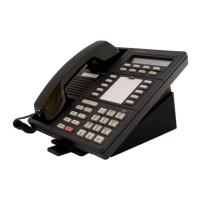MERLIN LEGEND Communications System Release 6.1
Feature Reference
555-661-110
Issue 1
August 1998
Features
Page 524Primary Rate Interface (PRI) and T1
Table 37. Sample T1 Switched 56 Dial-Plan Routing Table
Systemwide Programming Options 37
Clock Synchronization 37
Clock synchronization is an arrangement in which digital facilities operate from a
common clock. Whenever digital signals are transmitted over a communications
link, the receiving end must be synchronized with the transmitting end to receive
the digital signals without errors.
The system synchronizes itself by extracting the timing signal from the incoming
digital stream. If the system has one 100D module, that module provides its own
primary synchronization. If the system has at least one 800 NI-BRI module, more
than one 100D module, or a combination of 100D modules and 800 NI-BRI
modules, then one of the connections provides primary clock synchronization for
all 800 NI-BRI and 100D module ports and for the system’s time-division
multiplexing (TDM) bus. The primary clock synchronization source must be
identified during system programming. The factory setting either is the first 100D
module or the first port on the first 800 NI-BRI module in the carrier. This can be
changed through system programming.
In the event of a maintenance failure of primary synchronization, backup
synchronization can be provided by secondary and tertiary clock synchronization.
In addition, the source of synchronization is factory-set to Loop Clock Reference
Source so that the clock is synchronized to the outside source. With a 100D
module, it can be set to Local Clock Reference Source so that the clock is
free-running. However, this is not recommended for most permanent installations
or for systems with PRI. This setting must be made for the primary, secondary,
and tertiary synchronization sources.
In Release 6.0 and later systems (Hybrid/PBX mode only) with digital tandem
trunks, a single clock source should be used for all systems in the network.
Generally, the rules for assigning clock sources are the same as for single
systems. When the source for clock synchronization is not on a module in the
local system, it is assigned as
loop
. A loop clock source may be a port connected
Entry 1234... 24
Service T1 S56 T1 S56 T1 S56 T1 S56
Expected Digits 3 3 3 3
Example # 234 235 300 492
Digit deletion 1 1 1 1
Digit addition [none] [none] 67 69
Extension34356700 6992

